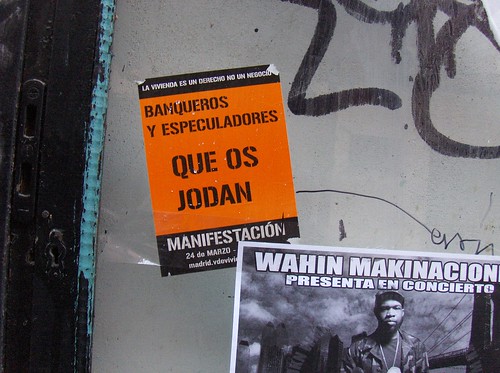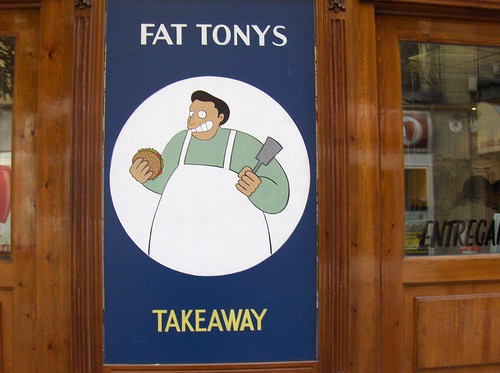
Saturday, June 30, 2007
In the suite
Here is a picture:

To take the virtual tour (picture of my private bathroom not included), visit this link
http://www.flickr.com/photos/gaelstat/sets/72157600570599303/
And try not to be too jealous, OK?
Friday, June 29, 2007
El segúrometro
I assume that one purpose of a blog is to function as a useful channel for venting. So that's what this post is about. Something I need to get off my chest. Something unashamedly geekish, I might add. So don't say you weren't warned.
Here's the thing. Every language has its peculiarities, and Spanish is no exception. For anyone trying to learn Spanish, one striking and frustrating feature of the language is its apparent obsession with the speaker's degree of certainty. Of course, it is possible in Spanish to utter a simple declarative statement: "Begoña wore a blue dress", for instance. As a general rule, such simple declarations of fact pose no particular problem.
Should you, however, depart from the realm of objectively ascertainable facts, then - to put it mildly - all hell breaks loose. For now you have entered into the shadowy world of opinion, conjecture, and supposition, a morass from which you cannot hope to emerge unscathed. For some odd reason, should you depart, even in the slightest degree, from a state of absolute certainty, a huge spectrum of expressions and idioms opens up before you, ranging from the mildest conjecture ("Maybe Begoña was wearing a dress. It could have been blue. I really couldn't say for sure") to a high degree of confidence ("I'm pretty sure Begoña was wearing that blue dress she wore at her sister's wedding") to near-certainty. Or anything along the continuum of probability from complete ignorance to absolute certainty. Here is a small sampling:
- Creo que
- Me parece que
- Supongo que
- Se supone que
- Me imagino
- Seguro que
- Estoy seguro de que
- Es seguro
- Para mí
- Yo diría
- Eso es
- Es probable que
- Es posible que
- Puede ser
- Puede
- Quizás
- Tal vez
- Probablamente
- Posiblemente
- A lo mejor
- Igual
- Lo mismo
and whatever you're having yourself.
What's the problem? Well, for one thing, some of these expressions are followed by the indicative, some by the subjunctive, some by either indicative or subjunctive (depending on, you've guessed it, the teachers' favorite copout, "the context"). And you'd better get it right, because if you don't you will immediately mark yourself as an ignorant foreigner, whose command of the language is surpassed by any Spanish ten-year old. Furthermore - and this is the kernel of my rant - apparently, each of the expressions above represents an exquisitely calibrated tick-mark along the spectrum of certainty. Even worse, there is complete unanimity among all teachers of Spanish that it is the responsibility of every educated person to be able to associate each expression with its corresponding degree of certainty, whether one is using such an expression oneself, or trying to understand what someone else is saying.
Diagrammatically:

if we think of "F" a representing a state of complete certainty, and "E" that of total ignorance, or sheer conjecture, then apparently, it matters - a lot - to your average Spanish speaker, just where one's opinion lies along the spectrum in between. Hence the bewildering plethora of expressions, not to mention the hideous indicative-subjunctive wrinkle.
Gentle readers, I don't wish to brag. But I do have a Ph.D. in statistics, so it's fair to say that I know a thing or two about probability. When this odd Spanish fascination with specifying the exact nuances of a speaker's degree of certainty was explained to me, my immediate thought (after "you've got to be kidding me!") was how inefficient the whole system was. All those phrases, and still no guarantee that each speaker is measuring by the same yardstick: Jose's "me parece que" may or not correspond to the same degree of belief as Maria's, leading to confusion all around. So my INTJ brain immediately came up with a brilliant alternative - namely that everyone could carry a little calibrated semicircular disc, with a movable arrow, along the lines of the fuel gauge pictured above, simply move the arrow along the continuum until the desired certainty point is reached, and Bob's your uncle. Thus, if I am 71% sure that Begoña was wearing that damned blue dress, I can indicate as much with a simple flick of the wrist. No fuss, no muss, no confusion.
Yes, yes - of course I understand the potential pitfalls. Before long the cool kids will be less than satisfied with the cumbersome, manually operated analog display. Inevitably, the gizmo will undergo the same kinds of developments as the wristwatch - digital displays, accessorization in different colors, use as a status symbol. Divers will want their instruments depth-proofed. But we know that these technological challenges can be met. And if the society cares so deeply about communicating the exactly nuanced shade of belief, then this solution seems like a bold, crisp, new alternative to the ambiguous thicket of phrases, moods, and tenses that currently ensnares the learner. ¡Hola, Juan! estoy 83.456% seguro de que Begoña ..... Of course, you'd still have the indicative/subjunctive choice to make. But a simple default rule (e.g. less than 50% - subjunctive, otherwise indicative) would work well.
Sadly, I regret to say that, when I have presented my proposal in class, it has been met with eye-rolling disapproval and dismissive contempt by sundry teachers. I can only conclude that the sheer genius-like simplicity of the proposal makes them nervous by threatening their job security.
Until this week, that is. We were (yet again!) reviewing the hideous list of phrases above and (yet again!) trying to figure out which took the indicative form of the verb, which the subjunctive. When suddenly, in the margin of the text, I noticed what - at first glance - appeared to be a thermometer:

Oddly enough, a thermometer that appeared to be graded from 0 to 100%. Then I read the word next to it. Sure enough, gentle readers, it said "segúrometro", and was being used to locate each of the phrases above along a spectrum of probability from 0 to 100%.
So here is the essence of my rant. For proposing a device already used in their own pedagogical materials I was subjected to mockery and abuse by my teachers. When (after all, I am an INTJ) I pointed out the injustice of this (in a good-natured way) - stares of bovine incomprehension. The complete isomorphism between the fuel gauge display and the thermometer display was apparently too much to grasp.If you've read this far, thank you for your indulgence. I feel much better now that I've gotten that off my chest. Next post will be back to our regularly scheduled blogging, with some useful information about the wines of Spain.
El pintor de la luz

Kinkade's weirdly compelling images of snug stone cottages whose unimaginably cozy interiors send an amber glow cascading out over their radioactively colorful gardens in the violet light of dusk.
For her entertaining review of Kinkade's literary efforts, follow this link:
The Writer of Dreck TM
Fortunately, where art is concerned, the Spanish are a little more selective. El pintor de la luz (not trademarked) refers not to el maestro de kitsch TM , but to the painter Joaquin Sorolla y Bastida, born in Valencia in 1863.
artrenewal.org link for sorolla (83 paintings)


Why am I telling you about Sorolla this evening? Because he was the subject of this evening's culture class. Which reminded me that our trip to the Museo Sorolla was one of the high points of Paddy's visit a few weeks ago. The museum is located in the artist's former home, and is an oasis of serenity on one of Madrid's busier traffic arteries. In addition to being filled with Sorolla's work, and some wonderful period furniture, the house is suffused with a kind of joy - it is obvious that the family who lived there was a happy and loving one. Here is a link to the museum's website:
Super laz-i-blog mode



The plain people of Ireland: Begob, but it looks like that marmalade cat is finally getting his weight under control.
The management: Silence, wretches! As I've told you before, Boris is not fat, he is merely big-boned. But now that you mention it, he does look a little slimmer - and more handsome than ever - in the picture above.
Thursday, June 28, 2007
Live from Millstreet
Millstreet LTV2 : Episode 60 part 2
As much as anything else that I could write or share with you, the two ten-minute video clips above illustrate what I will always miss about Ireland.
(Millstreet is a small town in west County Cork, near the Kerry border, perhaps best-known for hosting the Eurovision Song Contest in 1993).
Shilling for Schweppes
¿Sabes más que un niño de primaria?
¿Sabes más que un niño de primaria?
Two words: Jeff Foxworthy.
I am too outraged to write any more about this travesty right now.
The subjunctive in action

Note the use of the subjunctive form of the verb joder which, as this is a family blog, I am not at liberty to translate, the AngloSaxon form being considered offensive by many. The writer of the sign is expressing the wish that bankers and speculators engage in an activity which might be considered both obscene and biologically implausible.
Wednesday, June 27, 2007
What I've been Reading

In the U.S., the title is "I Thought my Father was God, and Other True Tales from NPR's National Story Project".
It is a wonderful book, which I cannot recommend highly enough. Here is - hands down - my favorite story from the entire collection. Since it treats of the redemptive power of mathematics, how could it not be?
Monday, June 25, 2007
The plight of the mileurista
The plain people of Ireland: This is an outrage!
The management: So what are you going to do about it? Sue me?
(indistinct sounds of muffled Hibernian indignation)
So, where was I? Oh, yes. A mileurista is someone whose monthly salary is approximately one thousand euros (1.000 €, as they would write it over here). A relevant figure because it represents the salary of a "typical" Spanish worker in their* twenties. As we are in Laz-i-Blog mode, let us accept the convenient fiction of the "typical" Spanish worker without further question.
Why am I telling you all this? Simply so that you will have a point of reference for the list of prices that follows. Because, clearly, the view of an affluent visiting foreigner (that would be me) is quite different from that of someone attempting to live in Madrid on a salary of 1.000 € per month. An approximate conversion factor is 1.00 € = $1.40.
- Price of breakfast (cappucino + croissant) at Faborit : 2.15 €
- Price of the same breakfast at Starbucks (sorry, eStarbucks) : 4 to 5 €
- Ticket to see "eShrek Tercero" : 6.50 €
- Cost of having 2 pants dry-cleaned : 10 €
- Cost of having 5 shirts laundered and ironed (never again!) : 20 €
- Cost of a haircut : 16 € + 2 € tip
- Cost of a 3-star hotel room in central Madrid : 80 € + 7% tax
- Cost of a 3-course lunch, including beer : 8.95 €
- Cost of a beer in a regular Madrid bar : 1.75 to 3.00 €
- Cost of a beer in a regular Seville bar : 1.10 to 2.00 €
- Cost of having the nice man at the Corte Inglés relojería replace your watch battery while you wait : 5.25 €
- Cost of the fan that Paddy bought as a present for ... : oops! I can't tell you that.
- Cost to rent any kind of decent apartment in central Madrid : starts at 600€ per month
- Cost of a bottle of water in any Madrid disco worth the name ª : 12 to 15 €
You begin to see why the poor mileuristas still live with their parents up to and beyond age 30.
* : yes, I know about agreement between subject and possessive pronoun, but his/her is an abomination.
ª: Remember, if trying to gain entry to a Madrid disco, the cardinal rule is: "no jeans, and no snickers". So, check your attitude at the door, bub!
The rain in e-Spain
stress : estrés
striptease : estriptis
streaking : estriquin
dinner jacket : esmoquin
choke (car part) : estarter
spanglish : espanglish
statistician : estadístico/a
to snort (drugs) : esnifar
snob : esnob
slalom : eslalon
sphincter : esfínter
sponge : esponja
slogan : eslogan
Sting : eSting
Springsteen : eSpring-eSteen
Spain : eSpain









